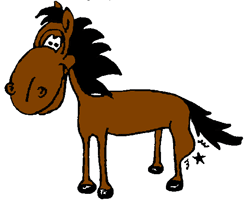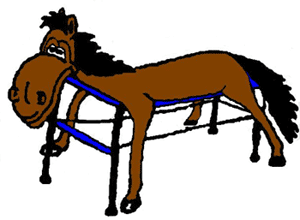6 Day Equine Massage Course:
Why Massage?
Approximately 60% of a horse’s total body weight is comprised of muscle and tendons. This musculature system is directly involved in locomotion and movement. Tension and spasms obstruct or prevent optimal movement and will cause problems in the horse’s performance. Healthy, spasm free, fully extensible muscle tissue is less prone to injury. As homeopathic and natural remedies are quickly becoming the choice for injuries, massage has emerged in the forefront of modalities used, as its benefits are profound, and almost instantly a difference can be observed as the horse will begin to move more easily.
 How Are Muscles Injured?
How Are Muscles Injured?
A blow to the muscle
- Ill fitting tack
- Overuse
- Over stretching
- Lack of stretching prior to an event
- over training
- Cooling down or warming up too quickly
- Result of poor or stressful conformation
- Forging, while trying to save itself from a fall
- Collisions with other horses
- Imbalanced rider
- Playing in the paddock
What Does Massage Do?
- Relaxation and relief of spasm
- Increases drainage of lymph – most effective work in lower limb swelling reduction
- Increases drainage of lactic acid, the prominent cause of fatigue
- Improve joint mobility
- Increases circulation in all systems – profound aspect of massage – can also be used to increase circulation to the hoof for horses that have: laminitis (48 hours after onset), navicular, abscess, general heat in hoof
- Improves flexibility and suppleness
- Decreases recovery time in injuries
- Reduction of toxic build up
- Increased tissue elasticity which allows for greater extension
- Increases or relaxes muscle tone
- Increases range of motion
- promotes peristalsis – movement of the gut – profound results have been reached in the relief of colic
- Reduces adhesions/scar tissue and restores extensibility of muscle fibers
- Assists in respiration, digestion and elimination
- Can improve mental attitude, as pain is dramatically reduced
 Goals of Massage Therapy:
Goals of Massage Therapy:
- To increase blood and lymphatic circulation
- To allow for full painless contraction of muscles
- To allow for full muscular and joint extensibility
- To improve the quality of life by decreasing pain and inflammation caused by injury and arthritis
- To enhance athletic performance
- To build stronger, suppler muscles that will be less prone to injury from strain
- To decrease recovery time between events
- To allow the horse to develop a smooth gait
- To deepen the bond between horse and rider
What is Taught:
The full and complete massage of the entire horse.
As a human registered massage therapist, I was taught Swedish massage technique, which is the bulk of the massage technique used with the horses; however, as I have taken numerous courses as an RMT for my continuing education credits, I have created a blend of various massage techniques that I have transposed to work with the horses. As these techniques were modified by me to work specifically with the horses, I have taken safety into consideration, along with the equine anatomy to make the most of each form of massage. We do not use any mechanical devices as I prefer hands on work over the entirety of the horse’s body based on their needs and getting feedback from them through my hands.
Safety protocol. How do we approach a horse, and how do we stay safe while working with the horses.
We all get far too comfortable working around our own horses (me too!), but when working with a new client, we need to exercise more caution, and adhere to safety principles in order to avoid injury to ourselves, or our horses. Certainly, the safety protocol should be used at all times – whether working with a horse that we know well, or one that we have just met!
Massage theory, principles of massage, massage manipulations, and their applications and effects on various systems.
The manipulations of massage, their proper names, and how each movement is unique.
I teach over 20 various movements – the more movements we have, the more versatility we have in our approach to soft tissue manipulation.
I teach 4 different massage techniques – not just Swedish massage. As an RMT, I have taken multiple courses in soft tissue release techniques, and have also learned through over 30 years of experience and work with soft tissue. I have transposed these techniques to work with the horses effectively and most of all – safely!
The phases of injury, how to spot them and how massage is administered based on the phase of injury.
Hydrotherapy uses and applications. When to use heat or cold, and various ways that we can administer heat or cold.
Equine anatomy: skeletal system and 30 major muscles, common landmarks
Contraindications: or when we should exercise caution during a massage. This is a very important segment of this course as we need to learn when it may not be safe to work with a horse-either their safety or ours!
Palpation procedures: how to correctly approach a horse, and how to gain greater muscle relaxation during a treatment, various common injuries and how to spot them quickly. How to assess muscle tissue and determine if it is the causation of the issue at hand.
Lower limb swelling/lymphatic drainage and increasing limb circulation techniques: a huge asset to learn to help your horse whether they have sustained an injury to the lower limb. Lymphatic drainage is the specific technique used for any swelling reduction and is covered in this course.
Colic relief:. I developed this technique in 2007 after one of my horses cribbed herself into a colic. We did/do have banamine on site at all times, but I wanted to try to help my horse without drugs. Within 20 minutes of work, the bout of colic was over – sure beats walking the horse for hours! I have shared this technique with my students, and have received much positive feedback on the swiftness of relief (if caught early). A special mention has to go out my mom ‘Mamma Body” as she taught me how to deal with a bad tummy when I was a little girl. This was the basis for the development of my technique!
Assessment: or how we find out where we need to focus our attention to have the horse gain the most benefit from the massage. This is an integral part of this course as it is important to learn and understand which areas to focus our massage time!
Stretches, stretches and more stretches. This is the cornerstone of muscle extensibility, without which the horse cannot reach its full potential. Some stretches have been developed by me and are unique to this course. Stretches should allow for: the safety of the therapist, safety of the animal, allow for as complete a stretch as possible for the animal – in that particular order. Our safety and the safety of the animal come first!
An exclusive aspect of equine massage is included in this course!!
This area of the course addresses behaviour issues as a direct correlation to physical distress. This area is a compilation of different human massage courses that I have taken, along with my many years of experience as a human RMT. I experimented with various techniques, and found a safe way to carry out the work. The horse’s responses were amazing! As this aspect of the course is designed by me, specifically tailored to work with horses, it gives this area of the course an exclusive area of information that is not taught in any other course.
In this area of study we will be looking at specific reasons horses respond through specific behaviour along with looking at resistance issues, refusals both under saddle and ground work we can formulate a plan, allow the horse’s input and give them relief through massage.
This area of study has yielded the highest pain relief results that I have ever used, and I am so very pleased to bring this aspect of care to this course.
Do I receive a Certificate?
At the conclusion of the course graduates receive their certificate, receipt, and take home their copy of the equine massage manual for future reference.
At the conclusion of the course, the graduates may then call themselves a
“Certified Equine Massage Therapist”
In the province of BC, the certificate is:
“”Certified Equine Massage Body Worker” (this is a legal technicality as the BC College of Massage Therapists – human – legally owns the term “massage therapy” and any derivatives therein)
Graduates may open a practice and charge for their services in any province in Canada.
